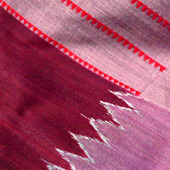Design Resource
Ikat Textiles of Nuapatna
Tie-Resist-Dye and Weaving
by
After the pattern to be woven is sketched on graph paper, degumming of the yarn (mostly cotton or silk) is done. Infact, any yarn undergoes this pre-treatment process (washing it with soda and soap water) to increase pliability and give the saree smooth and shinier texture. Once the yarn is dry, it is tied to a wooden frame. This is the weft of the saree. Bindings (cotton threads or rubber bands) that resist dye penetration are applied to narrow or wide bundles of these threads (from as few as four in very fine Ikat) in locations defined by the intended motif. After the bindings are in place, the threads are taken off the loom and immersed in the first dye bath. After drying, the bindings are cut away; the threads are strung onto the loom again and arranged carefully so that they match exactly. New bindings are put in place for all locations that should not receive color in the second round of dyeing. Then the tied threads are taken off the loom again, immersed in the next dye bath and so on, until the desired multicolored pattern has been created. This technique, called tie-resist-dyeing, requires great precision and meticulous planning - spanning over months, sometimes years.































